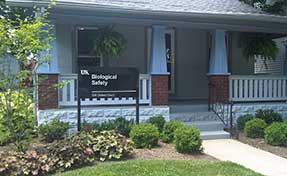Compressed Gas Cylinders
The outward appearance of a compressed gas cylinder is deceptive. The average standard size cylinder is pressurized at 2,200 pounds per square inch. These cylinders are safe under normal use; however, serious accidents have resulted from the misuse, abuse, or improper handling of compressed gases.
The following principles must be adhered to for safe storage, use, and transportation of compressed gas cylinders:
Cylinder Use, Storage, and Transport
- Use cylinders in an upright position, unless equipment manufacturer provides specific instructions otherwise.
- Turn all valves off when not in use.
- Do not modify relief valves.
- Know the contents, properties, and health hazards associated with the contents. Contents must be clearly labeled.
- Notify distributor immediately of any problems in the operation or condition of the cylinder (e.g. dents).
- Ensure all hardware connecting the cylinder to receiver is compatible with the pressure and contents to which it is exposed always use the correct gauge for the pressure and chemical to which it is exposed.
- Select the smallest reuseable cylinder compatible with the need.
- Always release pressure from regulator before disconnecting.
- Emergencies: in the event of a cylinder emergency such as a significant leak, evacuate the area, shut the door, and call 911.
- Always return compressed gas cylinders when finished. Vendors charge "demurrage fees" (rental) on compressed gas cylinders. These fees can often add up to exceed the purchase price of the gas if the cylinders sit for extended periods in storage. If cylinders cannot be returned to supplier, contact Environmental Management (859) 323-6280 for instructions.
- The valve protection cap should be left in place until the cylinder is secured and ready for use. Never struggle with a cylinder cap or use a screw driver to remove a cylinder cap. Do not drop cylinders or allow them to be struck with violent force.
- Secure cylinders in an upright position with proper chain, stand, or strap. Stored cylinders must have the valves closed and the valve covers must be in place.
- Never store cylinders of flammable gases (empty or full) near cylinders of oxygen or other oxidizers. A minimum separation of 20 feet or specially designed separation wall must be maintained. When practical, store cylinders a minimum of 20 feet from flammable liquids and away from sources of heat. If this is not practical, consult University Fire Marshal 257-6326 for additional options.
- Never store cylinders in a means of egress.
- Clearly mark "empty" cylinders with tag or sign. Writing "MT" in chalk or on label is not acceptable. Separate "empty" and "full" cylinders to avoid confustion and do not store empty cylinders in your laboratory.
- Cylinders should not be placed, stored or used on sides unless recommended by manufacturer.
- Cylinders must be hydrostaticly tested every 10 years. Note the last test date on top of the cylinder. Notify the supplier immediately if outdated cylinders are identified.
- Keep amount of flammable gases to a minimum. The number of flammable gas cylinders (10"x50") must not exceed 3 cylinders per 500 square feet in a non- sprinkled building or 6 cylinders per 500 square feet in a sprinkled building.
- Never rely on color-coding as a way to identify the compressed gas cylinder. Color codes are for the owner's convenience.
- Transport cylinders in an upright position.
- Never roll or drag full or empty cylinders. Preferred transport method is to secure cylinders (with valve covers in place) to a hand truck or similar mode of transport.
- Do not move a cylinder that has a regulator on it even if main tank valve is off.
- Treat "empty" cylinders with same respect as "full" cylinders.
- Transport of cylinders via stairs is discouraged unless other means of upper floor access is not available. When transporting cylinders via stairs, the cylinders must be capped and secured in an upright position to a hand truck suitable for use on stairs.
Extremely Toxic and Pyrophoric Gases
- Extremely toxic and/or pyrophoric gases require special care for use, storage, and transport. This may include special gas-monitoring systems, alarms, storage cabinets (or other ventilation devices), and/or special transport procedures.
- Notify Research Safety before purchasing or using extremely toxic and/or pyrophoric gases. Research Safety will assist in the evaluation of special facility needs and training requirements for using these materials.
The following gases or any other gas that has a threshold limit valve (TLV) less than 1 part per million (PPM), a flash point less than 0 F, or is pyrophoric should be registered with OH&S before purchase or use:
- Arsine - extremely toxic (TLV 0.05 PPM) and extremely flammable
- Chlorine - extremely toxic (TLV 0.5 PPM)
- Diborane - extremely toxic (TLV 0.1 PPM) and extremely flammable
- Germane - extremely toxic (TLV 0.2 PPM)
- Hydrogen Selenide - extremely toxic (TLV 0.05 PPM) and highly flammable
- Hydrogen Sulfide - extremely toxic (TLV 10 PPM) and very offensive odor
- Mercaptans (thiols) - extremely toxic (TLV's vary 0.5 PPM) flammable, offensive odor
- Phosgene (carbonyl chloride)- extremely toxic (TLV 0.1 PPM)
- Phosphine - extremely toxic (TLV 0.3 PPM)
- Silane - pyrophoric
- Stibine - extremely toxic (TLV 0.1 PPM)
- Any chemical that does not have a TLV.
Reviewed by Chemical Safety Committee June 7, 1996.
Approved by General Safety Committee September 17, 1996.
Revisions approved by General Safety Committee December 10, 1996.


